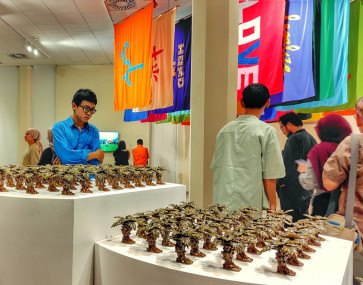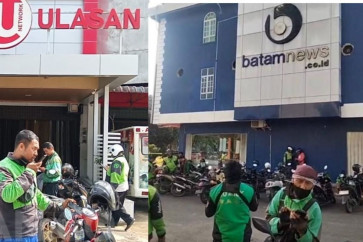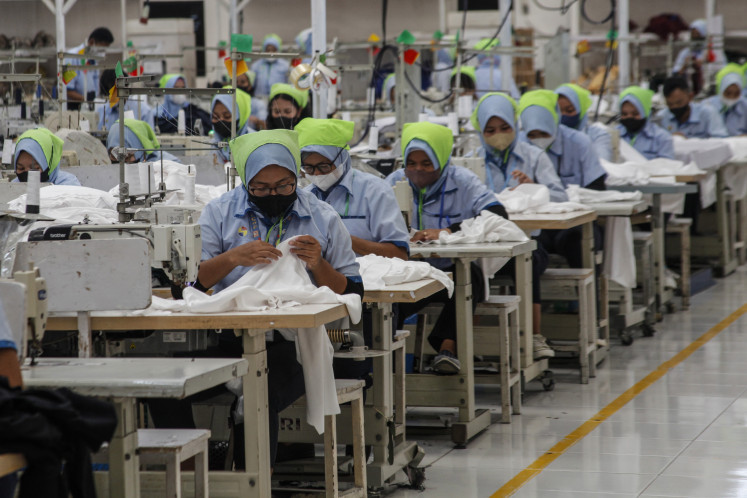Popular Reads
Top Results
Can't find what you're looking for?
View all search resultsPopular Reads
Top Results
Can't find what you're looking for?
View all search resultsWho’s who among Indonesian politicians of Minang descent
State diplomacy: Former prime minister and ambassador-at-large Sutan Sjahrir (left, front row) leads the Indonesian delegation at a hearing in the United Nations headquarters in Lake Success, New York, the United States, in 1947
Change text size
Gift Premium Articles
to Anyone
S
tate diplomacy: Former prime minister and ambassador-at-large Sutan Sjahrir (left, front row) leads the Indonesian delegation at a hearing in the United Nations headquarters in Lake Success, New York, the United States, in 1947. Then-foreign minister Agus Salim (right, second row with cap) was also part of the delegation. (kepustakaan-presiden.pnri.go.id)
Minangkabau figures have been actively involved in Indonesian politics since the preindependence movement of the 1920s. They were not only prominent in their era, but also represented a wide political spectrum — left, center and right.
One key figure of the preindependence movement is Sutan Ibrahim, better known as Tan Malaka, who won praise from Sukarno for his articles that the country’s founding president used as inspiration for his speeches in the 1920s.
Born in Pandang Gadang village in Lima Puluh Kota regency, West Sumatra, Tan Malaka was exposed to Western values — particularly the freedoms of expression, of organization and, most importantly, of thinking — when he pursued higher education in the Netherlands in 1913. He became more exposed to revolutionary movements when he studied at university there, before developing an interest in socialism and communism.
He returned to Hindia Belanda — a name for Indonesia prior to the country’s independence — in 1919 and fulfilled his childhood dream of becoming a teacher, before he became active in politics. He was an outspoken critic of the state leadership duo of Sukarno and Mohammad Hatta and an influential figure in the now-defunct Indonesian Communist Party (PKI) as well as the founder of the Proletarian Consensus (Murba) Party in 1948.
Tan Malaka was once jailed by Sukarno, but it was Sukarno himself who issued a decree posthumously granting him national hero status in March 1963.
Another key Minang figure in the 1920s was Mohammad Yamin. Born in Talawi, Sawahlunto City, West Sumatra, Yamin conceived the text of the 1928 Youth Pledge, one of the crucial moments in Indonesian history, marking the awakening of the youth to unite in the early preindependence movement.
Yamin served as Cabinet minister in different posts during Sukarno’s presidency. He was also the initiator behind the establishment of a number of state and private universities, including West Sumatra’s Andalas University, which was founded in December 1955.
The next generation of prominent Minang politicians was a sextet of West Sumatra-born figures, who were close confidantes of Sukarno during his two-decade presidency. They were Mohammad Hatta, Sutan Sjahrir, Abdul Halim, Mohammad Natsir, Assaat and Agus Salim.
Mohammad Hatta, born in Bukittinggi, West Sumatra, was the country’s first vice president. He and president Sukarno were dubbed the legendary duumvirate, not only because they partnered in postindependence state leadership, but they also stood side by side during the declaration of Indonesia’s Independence on Aug. 17, 1945.
Like Sukarno, Hatta became deeply involved in the nationalist movement, notably the preindependence movement, during his higher education period in the Netherlands in the 1920s and early 1930s, and at home.
Hatta quit as vice president in 1956 after disagreement with Sukarno over a number of state matters.
Sjahrir was the country’s first prime minister, serving from Nov. 14, 1945 until July 3, 1947. Born in Padang Panjang, West Sumatra, he established the now-defunct Indonesian Socialist Party (PSI) in 1948. Sjahrir died in exile in Zurich, Switzerland, and was granted posthumous national hero status on his passing on April 6, 1966.
Abdul Halim, born in Bukittinggi, was the country’s fourth prime minister. A medical doctor by training, Halim studied at GHS (Geneeskundige Hooge School) or Medical School, which is now the School of Medicine of the University of Indonesia, but never practiced as a doctor during the early years of the postindependence era.
Halim was also active in sports organizations. He helped establish the Voetbalbond Indonesische Jakarta (now the Persija soccer club) in 1927 and served as its chairman for several years. Between 1951 and 1955, he was the vice chairman and then chairman of the Indonesian Olympic Committee (KOI).
Natsir was the country’s fifth prime minister. Born in Alahan Panjang, Solok regency, West Sumatra, Natsir established the Muslim-based Masjumi Party. Apart from his political activities at home, he was actively involved in global Islamic organizations — once president of the World Muslim Congress and the World Council of Mosques.
Assaat, who was born in Pincuran Landai village, Banuhampu, Agam regency, West Sumatra, served as caretaker president of the Republic of Indonesia during the emergency administration of the republic in Yogyakarta from Dec. 27, 1949, to Aug. 15, 1950.
Last but not least in the sextet was Agus Salim. Born in Koto Gadang, Agam regency, Agus Salim served in the Cabinet of Sukarno, first as the junior foreign minister from March 12, 1946, to July 3, 1947, and then as foreign minister from July 3, 1947, until Dec. 20, 1949. Agus Salim was granted national hero status in 1961.
The end of the Sukarno presidential era also brought to an end an era of Minang politicians’ prominence, as not a single Minang figure has held state leadership positions since.
The New Order government of second president Soeharto, however, still saw an abundance of Minang figures in the Cabinet. Cabinet ministers of Minang descent were still common during the three-decade rule of Soeharto. They included Emil Samil, who served in Soeharto’s Cabinet in several different posts and terms and also a nephew of Agus Salim, Harun Zain, Azwar Anas and Hasan Basri Durin. The last three first served as governors of West Sumatra before they were appointed by Soeharto as ministers.
Their number, however, started to decline in the Reform Era with only a maximum two Cabinet posts held by Minang figures in every edition of the Cabinet since 1999. There is apparently only one Minang figure in the current Joko “Jokowi” Widodo Cabinet — Energy and Mineral Resources Minister Arifin Tasrif.
It remains to be seen whether Minang figures, or politicians, will able to bring back the glory of their predecessors to the future. Only time will tell.
— From various sources










